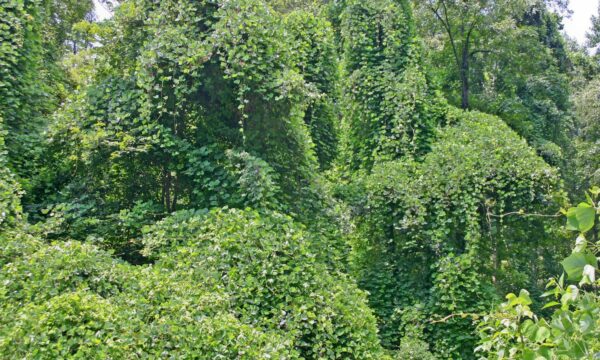Garlic mustard (Alliaria petiolate) is a highly destructive invader in North America. As well as hindering the survival of native plants, it poses a particular threat to the survival of the rare West Virginia white butterfly (Pieris virginiensis).

What are the characteristics of garlic mustard?
Garlic mustard, also known as Jack-by-the-hedge, likes shady spots so is usually found on the edges of woods, forests and in hedgerows.
The weed grows up to one metre and takes two years to complete its lifecycle. It grows young leaves in its first season, which it keeps over winter, and then flowers in the spring of its second year. The heart-shaped leaves are like nettles. When the leaves and seed of the weed are crushed, they smell of garlic.
How invasive is it?
Garlic mustard is one of the most rapidly increasing woodland invasive plant species, spreading across the USA and south-eastern Canada at a rate of nearly 2,500 square miles per year. The weed is also found in the UK but has not proved as problematic there.

It is thought that the plant was most likely introduced to North America in the 19th century when it was taken from its native habitat of Eurasia by settlers for medicinal and culinary use.
What impact is it having on native biodiversity?
Garlic mustard has no natural enemies or competition so it poses an even greater threat to ecosystems. As an allelopathic herb, the weed releases compounds which inhibit the growth of other plants around.
Its spread is negatively impacting the rare West Virginia white butterfly (Pieris virginiensis). The female butterflies are attracted to laying their eggs on the plant. However, larvae are unable to develop on the plant, making it a trap for this important butterfly species.
The plant also blocks the sunlight of native species, stunting their growth and out-competing them for moisture and vital nutrients. The weed’s dominance is strengthened by climate change which continues to alter seasons faster than native plants can adapt.
How can we control garlic mustard?
Traditional methods of controlling this invasive weed are costly and need to be repeated over several years. This includes removing the weed by hand, setting fire to the plant, cutting it back and using herbicide treatments for larger infestations.
Biocontrol using natural enemies from the garlic mustard’s native habitat could prove a more sustainable solution to controlling the weed in North America.
In 2018, the first biocontrol agent against garlic mustard in North America was introduced. Together with partners, CABI researched the possibility of using specially selected and tested insects from the native range in order to safely control the plant’s spread and impact in the introduced range. The project is being monitored to see what impact it has on the growth and spread of this invader.

Invasive species expertise
Invasive species are one of the five leading drivers of global environmental change. CABI has worked on invasive species for over 100 years. We provide robust data on the impacts of invasive species on human well-being and the environment. We also develop practical ways of addressing the biggest threats.
Find out more about our work on invasive species.
Further information
Garlic mustard (Alliaria petiolate) datasheet on CABI compendium
Biological control of garlic mustard
Further reading
Related News & Blogs
Nearly 25 years of research precedes release of seed-feeding weevil to fight garlic mustard in North America
After nearly 25 years of research, permission has been granted by the Canadian Food Inspection Agency (CFIA) to release the seed-feeding weevil Ceutorhynchus constrictus to sustainably control invasive garlic mustard plant in Canada. Garlic mustard (Al…
31 March 2025




